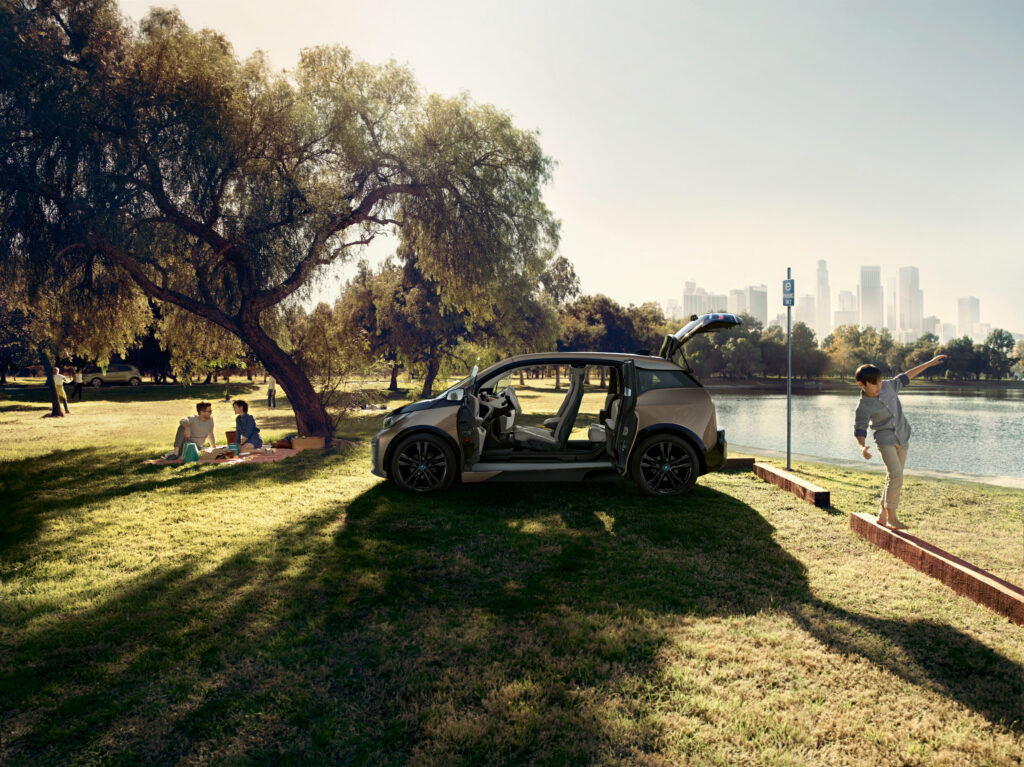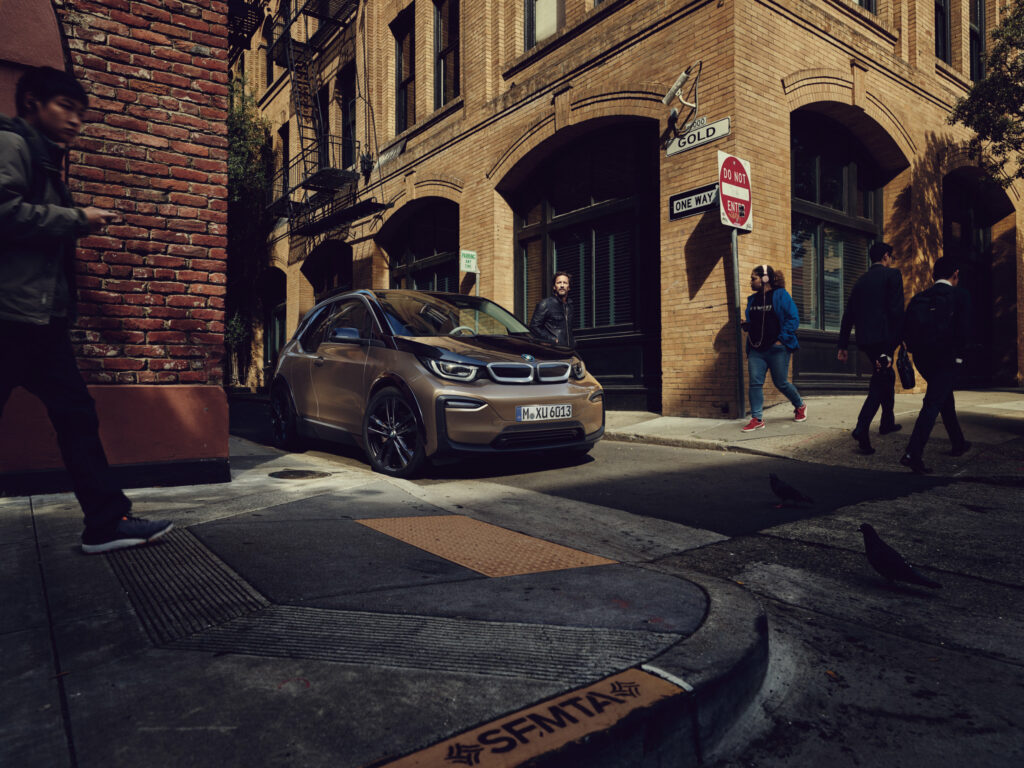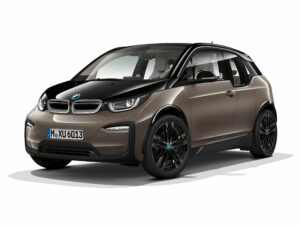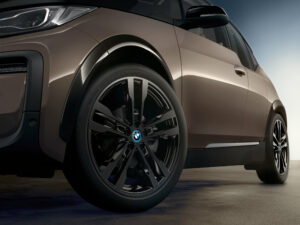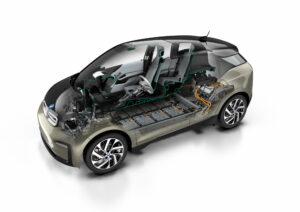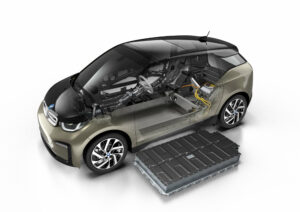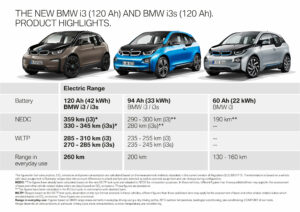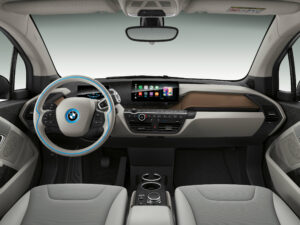BMW i3s
The new BMW i3s includes many design elements that emphasize its particularly dynamic character. Both front and rear bumpers feature powerful contours and a U-shaped contrasting finish. The side sections of the front bumper are edged with BMW I Blue or Frozen Grey accent strips, further emphasizing the vehicle’s width. The i3s grille is painted in high-gloss black to make it look larger and more distinctive. The rear bumper of the new BMW i3s also has clear contours with colored trim.

The BMW i3s comes standard with a sport suspension and exclusive 20-inch twin-spoke alloy wheels, which are 20 mm wider than previously available versions. They can be ordered in Bicolour and Jet Black.
Technical features of the BMW i3s
The i3s has a high-performance 135 kW/184 hp electric motor that generates a maximum torque of 270 Nm. Its drive system includes modified motor control and special tapered roller bearings, which are used to optimize power delivery and performance at higher speeds.

The BMW i3s also boasts a sporty suspension with specially designed springs, dampers, and anti-roll bars. Drivers can select SPORT mode using the driving control switch. This results in a more direct acceleration response and stiffer steering characteristics to further emphasize the car’s sportiness.
The BMW i3s accelerates from 0 to 100 km in just 6.9 seconds, reaching a top speed of 160 km/h (electronically limited). The car has a combined electricity consumption of 14.3 kWh per 100 kilometers on the NEDC cycle. Its range is 280 kilometers on the NEDC cycle, from 235 to 245 kilometers according to the WLTP, and up to 200 kilometers in everyday use.

| Performance | |
| Acceleration 0 – 100 km/h | 6.9 sec |
| Top Speed | 160 km/h |
| Electric Range | 230 km |
| Total Power | 135 kW (184 PS) |
| Total Torque | 270 Nm |
| Drive | Rear |
| Battery and Charging | |
| Battery Capacity | 42.2 kWh |
| Battery Useable | 37.9 kWh |
| Europe | |
| Charge Port | Type 2 |
| Port Location | Right Side – Rear |
| Charge Power | 11 kW AC |
| Charge Time (0->230 km) | 4h15m |
| Charge Speed | 57 km/h |
| Fastcharge Port | CCS |
| FC Port Location | Right Side – Rear |
| Fastcharge Power (max) | 49 kW DC |
| Fastcharge Time (23->184 km) | 36 min |
| Fastcharge Speed | 260 km/h |
| Energy Consumption EVDB Real Range | |
| Range | 230 km |
| Vehicle Consumption | 165 Wh/km |
| CO2 Emissions | 0 g/km |
| Vehicle Fuel Equivalent | 1.9 l/100km |
| NEDC Ratings | |
| Range | 345 km |
| Rated Consumption | 140 Wh/km |
| Vehicle Consumption | 110 Wh/km |
| CO2 Emissions | 0 g/km |
| Rated Fuel Equivalent | 1.6 l/100km |
| Vehicle Fuel Equivalent | 1.2 l/100km |
| WLTP Ratings | |
| Range | 283 km |
| Rated Consumption | 161 Wh/km |
| Vehicle Consumption | 134 Wh/km |
| CO2 Emissions | 0 g/km |
| Rated Fuel Equivalent | 1.8 l/100km |
| Vehicle Fuel Equivalent | 1.5 l/100km |
| Rated = official figures as published by manufacturer. Rated consumption and fuel equivalency figures include charging losses. | |
| Vehicle = calculated battery energy consumption used by the vehicle for propulsion and on-board systems. | |
| Real Energy Consumption between 107 – 237 Wh/km | |
| City – Cold Weather | 165 Wh/km |
| Highway – Cold Weather | 237 Wh/km |
| Combined – Cold Weather | 194 Wh/km |
| City – Mild Weather | 107 Wh/km |
| Highway – Mild Weather | 185 Wh/km |
| Combined – Mild Weather | 143 Wh/km |
|
Energy use for each trip will vary considerably depending on the driver and the conditions. Therefore, we have provided a range of estimates which can be useful in developing an understanding of the potential benefits of this technology. |
|
| Dimensions and Weight | |
| Length | 4006 mm |
| Width | 1791 mm |
| Width with mirrors | No Data |
| Height | 1590 mm |
| Wheelbase | 2570 mm |
| Weight Unladen (EU) | 1365 kg |
| Gross Vehicle Weight (GVWR) | 1730 kg |
| Max. Payload | 440 kg |
| Cargo Volume | 260 L |
| Cargo Volume Max | 1100 L |
| Cargo Volume Frunk | No Data |
| Roof Load | 0 kg |
| Tow Hitch Possible | No Data |
| Towing Weight Unbraked | 0 kg |
| Towing Weight Braked | 0 kg |
| Vertical Load Max | No Data |
| Miscellaneous | |
| Seats | 4 people |
| Isofix | Yes, 2 seats |
| Turning Circle | 10.3 m |
| Platform | No Data |
| Car Body | Hatchback |
| Segment | B – Small |
| Roof Rails | No |
| EV Dedicated Platform | No Data |
Home and Destination Charging (0 -> 100%)
A public charging station is required to use the highest possible charging rate. The EVSE/charging station’s charging capacity affects how long it takes to fully charge the battery. The table below shows all possible options for fully charging the BMW i3s.
In Europe, plugging an electric car into an outlet is often as easy as plugging it into a household outlet, but there are differences from country to country. The table below shows the different ways to charge the BMW i3s, but in some countries some chargers may not be available.
Type 2 (Mennekes – IEC 62196)

| Charging Point | Max. Power | Power | Time | Rate |
| Wall Plug (2.3 kW) | 230V / 1x10A | 2.3 kW | 19h30m | 12 km/h |
| 1-phase 16A (3.7 kW) | 230V / 1x16A | 3.7 kW | 12h15m | 19 km/h |
| 1-phase 32A (7.4 kW) | 230V / 1x32A | 7.4 kW | 6h15m | 37 km/h |
| 3-phase 16A (11 kW) | 400V / 3x16A | 11 kW | 4h15m | 54 km/h |
| 3-phase 32A (22 kW) | 400V / 3x16A | 11 kW | 4h15m | 54 km/h |
Fast Charging (10 -> 80%)
If you want to enjoy driving an electric car, one of the most important features to consider is the number of miles per hour the car can travel while charged. This is called the “range” of the car. All electric cars have a certain range, even if they are 100% charged. This is because they do not have an internal combustion engine to lean on if you need to drive a long distance.
Max. Power: The maximum power provided by the charging point
Avg. Power: The average power provided by the charging point during a session of 10% to 80%.
Time: the time it takes to charge from 10% to 80%
Speed: the average charging rate during the session of 10% to 80%
Combined Charging System (CCS Combo 2)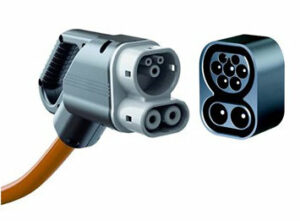
| Charging Point | Max. Power | Avg. Power | Time | Rate |
| CCS (50 kW DC) | 49 kW | 47 kW | 36 min | 260 km/h |
| CCS (175 kW DC) | 49 kW | 47 kW | 36 min | 260 km/h |
| CCS (350 kW DC) | 49 kW | 47 kW | 36 min | 260 km/h |
| Brand | BMW |
| Model | i3s |
| Body Style | Hatchback |
| Car Engine | Electric |
| Motor power | 135 |
| Maximum Torque, Nm | 270 |
| Battery Energy, kWh | 42.2 |
| Power reserve (NEDC/EPA/WLTP), km | - / - / 355 |
| Level Charging (230/400/DC), hours | - / 4.15 / 0.36 |
| Electrical Acceleration, 0-100 km/h (0-62.1 mph) in sec | 6.9 |
| Top Speed, km/h | 160 |






